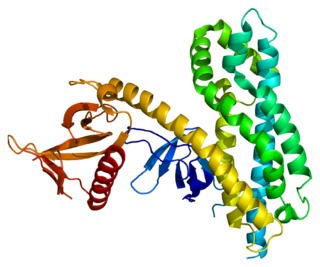Related Research Articles

Trpc4-associated protein is a protein that in humans is encoded by the TRPC4AP gene.

Symplekin is a protein that in humans is encoded by the SYMPK gene.

AT rich interactive domain 4A (RBP1-like), also known as ARID4A, is a protein which in humans is encoded by the ARID4A gene.

Synaptotagmin-like protein 1 is a protein that in humans is encoded by the SYTL1 gene.

Cortactin-binding protein 2 is a protein that in humans is encoded by the CTTNBP2 gene.

WD repeat-containing protein 3 is a protein that in humans is encoded by the WDR3 gene.

Rho guanine nucleotide exchange factor 4 is a protein that in humans is encoded by the ARHGEF4 gene.

DCC-interacting protein 13-beta is a protein that in humans is encoded by the APPL2 gene.

Nuclear protein localization protein 4 homolog is a protein that in humans is encoded by the NPLOC4 gene.

Protein arginine N-methyltransferase 3 is an enzyme that in humans is encoded by the PRMT3 gene.

HMG box transcription factor BBX also known as bobby sox homolog or HMG box-containing protein 2 is a protein that in humans is encoded by the BBX gene.

Putative sodium-coupled neutral amino acid transporter 10, also known as solute carrier family 38 member 10, is a protein that in humans is encoded by the SLC38A10 gene.

CSRP2 binding protein is a protein that in humans is encoded by the CSRP2BP gene.

Eukaryotic translation initiation factor 4E family member 3 is a protein that in humans is encoded by the EIF4E3 gene.
Protein arginine methyltransferase 8 is a protein that in humans is encoded by the PRMT8 gene. Arginine methylation is a posttranslational modification involved in a number of cellular processes, including DNA repair, RNA transcription, signal transduction and protein compartmentalization. PRMT8 binds and dimethylates Ewing sarcoma breakpoint region 1 (EWS) protein.
Malignant Brain Tumor domain containing 1 is a protein that in humans is encoded by the MBTD1 gene. The gene is also known as SA49P01.

DIP2 disco-interacting protein 2 homolog B (Drosophila) is a protein that in humans is encoded by the DIP2B gene. A member of the disco-interacting protein homolog 2 protein family, it contains a binding site for the transcriptional regulator DNA methyltransferase 1 associated protein 1, as well as AMP-binding sites. The presence of these sites suggests that DIP2B may participate in DNA methylation. This gene is located near a folate-sensitive fragile site.
Solute carrier family 25, member 29 is a protein that in humans is encoded by the SLC25A29 gene. The gene is also known as CACL and C14orf69. SLC25A29 belongs to a protein family of solute carriers called the mitochondrial carriers.
Zinc finger protein 367 is a protein that in humans is encoded by the ZNF367 gene. The human gene is also known as ZFF29 and CDC14B; the orthologue in mice is Zfp367. ZNF367 contains a unique Cys2His2 zinc finger motif and is a member of the zinc finger protein family.
Solute carrier family 22, member 21 is a protein that in the house mouse is encoded by the Slc22a21 gene. The gene is also known as Octn3 and Slc22a9. Slc22a21 belongs to a protein family of solute carriers.
References
- 1 2 "Ankyrin repeat and sterile alpha motif domain containing 4B" . Retrieved 2011-12-06.
- ↑ "Dysmorphology data for Anks4b". Wellcome Trust Sanger Institute.
- ↑ "Salmonella infection data for Anks4b". Wellcome Trust Sanger Institute.
- ↑ "Citrobacter infection data for Anks4b". Wellcome Trust Sanger Institute.
- 1 2 3 Gerdin AK (2010). "The Sanger Mouse Genetics Programme: High throughput characterisation of knockout mice". Acta Ophthalmologica. 88 (S248). doi:10.1111/j.1755-3768.2010.4142.x. S2CID 85911512.
- ↑ Mouse Resources Portal, Wellcome Trust Sanger Institute.
- ↑ "International Knockout Mouse Consortium".
- ↑ "Mouse Genome Informatics".
- ↑ Skarnes, W. C.; Rosen, B.; West, A. P.; Koutsourakis, M.; Bushell, W.; Iyer, V.; Mujica, A. O.; Thomas, M.; Harrow, J.; Cox, T.; Jackson, D.; Severin, J.; Biggs, P.; Fu, J.; Nefedov, M.; De Jong, P. J.; Stewart, A. F.; Bradley, A. (2011). "A conditional knockout resource for the genome-wide study of mouse gene function". Nature. 474 (7351): 337–342. doi:10.1038/nature10163. PMC 3572410 . PMID 21677750.
- ↑ Dolgin E (June 2011). "Mouse library set to be knockout". Nature. 474 (7351): 262–3. doi: 10.1038/474262a . PMID 21677718.
- ↑ Collins FS, Rossant J, Wurst W (January 2007). "A mouse for all reasons". Cell. 128 (1): 9–13. doi: 10.1016/j.cell.2006.12.018 . PMID 17218247. S2CID 18872015.
- ↑ van der Weyden L, White JK, Adams DJ, Logan DW (2011). "The mouse genetics toolkit: revealing function and mechanism". Genome Biol. 12 (6): 224. doi:10.1186/gb-2011-12-6-224. PMC 3218837 . PMID 21722353.